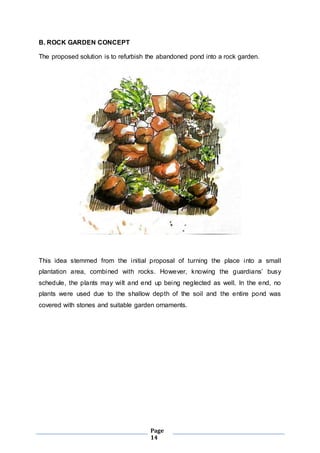This document is a project report for a group of students who worked on a community engagement project at St. Barnabas Shelter Home. It identifies three main issues at the shelter home: unused spaces in the boys' and girls' corridors, an abandoned pond, and rusty playground equipment. The group's proposed solutions were to utilize the empty corridor spaces by adding mural paintings and drawing boards, transform the abandoned pond into a rock garden, and repaint the playground equipment for safety and aesthetics. The report provides details on the objectives, organization of the shelter home, reasons for engaging with this site, problem statements, and proposed solutions.
![ENVIRONMENTAL SUSTAINABLE DESIGN
[ARC 1413]
Project 1: My community My Commitment
Exploring the sense of environmental and community engagement as
future designer
“Innovation for Generation”
PROJECT REPORT
Group members:
Alexander Chung Siang Yee
1003A78541
Evelyn Sinugroho
0318217
Jillian Goh Joon Jin
0901G69895
Julia Shenjaya
0317774
Liau Wen Bin
0319062
Lim Choon Wah
0311265
Lim Ming Chek
0317743
Ling Yuan Ming
0318758
Wong Teng Chun
0318538
Page 1](https://image.slidesharecdn.com/finalesd-141209045533-conversion-gate01/85/Environmental-Sustainable-Design-Final-Report-1-320.jpg)









































![Page
43
Reference list
Alden, A. Where Things Come from : Rock Materials. [ONLINE] Available at:
http://geology.about.com/od/mineral_resources/tp/Where-Rock-Materials-Come-
From.htm. [Last Accessed 29 October 2014].
Gray, J (2014). Stone Construction. [ONLINE] Available at:
http://www.sustainablebuild.co.uk/constructionstone.html. [Last Accessed 28
October 2014].
Mazzocco, M. P. (2011). Sustainable Materials . [ONLINE] Available at:
http://blog.bibliocad.com/materiales-sustentables-vidrio-ceramicos-aberturas-pinturas?
lang=en. [Last Accessed 27 October 2014].
Papasavva, S. , Kia, S. , (2002). Life Cycle Environmental Assessment of Paint
Processes. Journal of Coating Technology. 74 (), pp.65-76
Secrest, R (2008). How paint is made. [ONLINE] Available at:
http://www.madehow.com/Volume-1/Paint.html. [Last Accessed 9 Nov 2014].](https://image.slidesharecdn.com/finalesd-141209045533-conversion-gate01/85/Environmental-Sustainable-Design-Final-Report-43-320.jpg)

